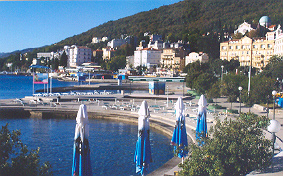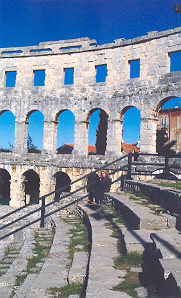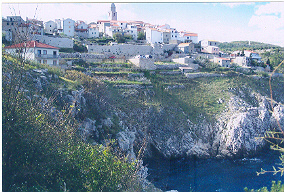by Valerie Summers
As I disembarked at the airport in Frankfurt, Germany, a fellow American passenger asked if this was my final destination. I replied that I was taking a connecting flight to Zagreb. “Where’s that?” he questioned. “It’s the capital of Croatia,” I replied. “Where is Croatia?” was his response, much to my surprise. “It is part of what once was called Yugoslavia” I explained.
The spectacular northern Adriatic coast of this diverse country borders Italy, just 120 miles from Venice. Although beautiful, unspoiled Croatia looms high on the list of choice vacation spots for many Europeans, it appears that only American travelers in the know have discovered this land of culture, towering mountains, wineries, clean air, fresh water, scrumptious cuisine, resorts and one of the most spectacular coastlines in the world which features more than 1,000 islands. An additional draw is the cost of vacationing there as well as the fact that most locals speak English. It is one of the few places that Americans can stretch their vacation dollars by converting them into Croatian kuna since Croatia is not yet a member of the European Union where the worth of the American just keeps sinking.
More than 20 years ago I visited the southern portion of what was then Yugoslavia and I noted many changes during my recent stay, all of them good. Featuring a potpourri of different types of architecture, culture and cuisine, Croatia has created its own unique identity. On this visit, I began in Zagreb, where I discovered a vibrant 900 year old capital city bustling with young people, fashionable shops and fine restaurants. I explored the mix of history and modern living in Zagreb, where I stayed at its most beautiful hotel, the historic art nouveau Regent Esplanade in the heart of the city. I also visited a hostel which accommodates budget travelers and found every type of lodging in between. Walking through bustling squares, lush flower filled parks and along streets I heard laughter and conversation echoing from coffee houses, bars and restaurants.
During my discovery of Zagreb, I came across one of the city’s most renowned buildings, St. Mark’s Church, its roof made of multi-colored enamel tiles with the coat of arms of Zagreb and of the Triune Kingdom. This bustling metropolis offers its share of cultural venues. I explored a variety of quality museums including an art museum and former 17th century residence housing the works of renowned sculptor Ivan Mestrovic. Continuing on, I admired the Gothic Zagreb cathedral which still possesses several 14th century elements and the stunning neo-baroque Croatian National Theater that regularly hosts world-famous entertainment. Zagreb is in the midst of rediscovering its glory days surrounded by modern shops and treasured centuries old buildings.
Due to its occupation by so many other countries in the past, Croatia’s architecture is widely varied as is its cuisine, reflecting the cultures of its past conquerors including Italy, Hungary, Austria and Turkey. Foodies and oenophiles are sure to enjoy visiting Croatia where it is not unusual to be served five course meals which might include truly fresh seafood, lamb, prosciutto, veal, soup, sheep cheese, salad, pizza, homemade pasta or even truffles accompanied by fine local wines. Mealtimes are special events to the Croats who enjoy a tradition of leisurely dining and socializing. Two dining experiences which I particularly enjoyed took place at Daniella Volosko’s Plavi Podrum restaurant in Volosko which serves exquisite seafood presentations and at the elegant Restaurant Zigante, specializing in rare truffle dishes, situated in the countryside of Istria’s heart-shaped peninsula.
My next stop was Istria’s popular seaside destination, Opatija. It boasts a combination of the continental and Mediterranean climate resulting in generally mild temperatures year ‘round. The elegant resort city is lined with beautifully maintained buildings with decorative facades and includes lush, flower filled public gardens. Each morning I walked along the coastal promenade following the harbor filled with boats of every description. It is no wonder that water sports are popular pastimes in this area. It’s carefully monitored transparent, clean, warm, aquamarine sea beckons water sports enthusiasts to sail, swim, dive and windsurf.
When I prowled the shopping displays along the main street I was often lured inside where I could not resist making several purchases. Shopping in Croatia offers visitors more for their money. As for cultural interests, Opatija’s summer stage features opera, ballet, symphony orchestras, folklore performances, rock and pop concerts, plays and films. An all year ‘round resort, the city’s cultural presentations move to hotels and churches during winter months helping to make this area is one of the country’s most favored vacation spots.
Another of Istria’s seaside must see destinations for history buffs is Pula whose main attraction is an ancient Roman amphitheater which appears in amazingly good condition and is listed as a UNESCO world heritage site. The construction of the Pula Arena dates from the second half of the first century and is said to have been built in honor of a woman from Pula.
Continuing my visit to several regions in the north, I headed into the wine country. From generation to generation, Croats have produced exquisite wines. However, during the time when the Yugoslavian government was in power, the industry died, but has been given new life as vintners spring up reclaiming the art of fine wine making. Because of its favorable geographical position, Croatia offers a varied range of top quality wines produced in both its Mediterranean Adriatic coastal zone and also in the inland portion of the country. The several wineries which I visited were all family run and operated and produced a variety of fine wines. The Zdjelarevic winery at Brodski Stupnik in the Slavonia wine region featured a romantic small hotel and popular restaurant and tasting room surrounded by vineyards covering rolling hills as far as the eye could see. Their specialties included Italian Reisling, Chardonnay and Sauvignon and they ship to any part of the world via their comprehensive website.
On the island of Krk (that’s right…no vowels), on the Adriatic’s Bay of Kvarner, I stopped for a sampling at Vrbnik where a group of tourists sat around a long table tasting and singing in harmony. This winery is best known for its Zlahtina but also features sherry, sparkling wine and grape brandy. Several other wineries in the area produce a variety of award-winning wines, many with tasting rooms for visitors. I happily discovered a plethora of various types of fine wines, both red and white, produced in the area by a variety of vintners, some familiar and others new to my palate. A bonus for this discovery of the Croatian vineyards was driving through the region’s pristine countryside; sampling freshly made olive oils and stopping to explore its centuries old hill towns.
Krk remains happily in a time warp, its inhabitants living the lives of ordinary people tending to their vines, preparing their freshly caught or freshly picked meals and always offering a friendly “hello.” Croats are big on really fresh fish, produce and herbs. Krk offers its visitors an opportunity to relax in its beautiful surroundings and partake of its unending hospitality.
My final stop took me to the medieval resort town of Lovran situated on the southeast coast of Istria. Forests of sweet chestnut and laurel trees added to the lushness of this picturesque coastal community, known as part of the Opatija Riviera with its mild Mediterranean climate. Water sports, sunning on its beaches, walks along the seaside promenade, hiking and biking rank high with Lovran visitors. Mountain climbing the slopes of the Ucka Mountains provides an outlet for outdoor enthusiasts who enjoy a challenge. One evening I dined at the restaurant of the Hotel Draga di Lovrana, high in the mountains. The scenery along and below the winding road to the top was spectacular. Once there, I was seated at a window side table offering an unobstructed view of the moon’s reflection shimmering on the sea below. I dined on freshly caught seafood, dipping my just baked bread into newly pressed olive oil while sipping a glass of fine Croatian wine, the perfect end to my visit.
Changes are coming to Croatia quickly with luxury resorts being built on its picture perfect islands. You can’t stop progress, but right now and hopefully for the future, this exquisite country, with its dramatic coastline, forested mountains, charming villages and exceptional hospitality will remain unspoiled.
For information:
Hotel Draga di Lovrana
www.dragadilovrana.hr
Hotel Palace, opened in 1907, remains quietly elegant, mixing art nouveau décor and contemporary amenities. Gracious staff. Two blocks from the Old City.
Strossmayerov trg 10
Zagreb, Croatia
www.palace.hr
Lovran Tourism & Opatija Tourism
www.croatia.hr
Regent Esplanade, built in 1925 to cater to travelers on the Orient Express and has hosted many celebrities and dignitaries including Orson Welles, Queen Elizabeth II, Alfred Hitchcock, Richard Nixon, and Elizabeth Taylor. The grand hotel has combined the elegance of days gone by with modern luxury. Its contemporary dining room, Zinfandel’s, is beautifully decorated and serves fine cuisine accompanied by an excellent wait staff. The hotel’s total luxury services include a personalized bath menu featuring in room baths to satisfy their guests every mood and need including the Aquamarine providing relaxation, the Great Gatsby created especially for the male hedonist, and the Regent Esplanade Zagreb representing the pinnacle of luxury.
Mihanoviceva 1
Zagreb, Croatia
www.regenthotels.com
Restaurant Plavi Podrum
Supilove obala 12
51413 Volosko, Croatia
www.plavi-podrum.com
Restaurant Zigante
www.ziganteteartufi.com
Tourist Association of Krk
www.tz-krk.hr
Zagreb Tourism
www.zagreb-touristinfo.hr
Zdjelarevic Winery
www.zdjelarevic.hr





